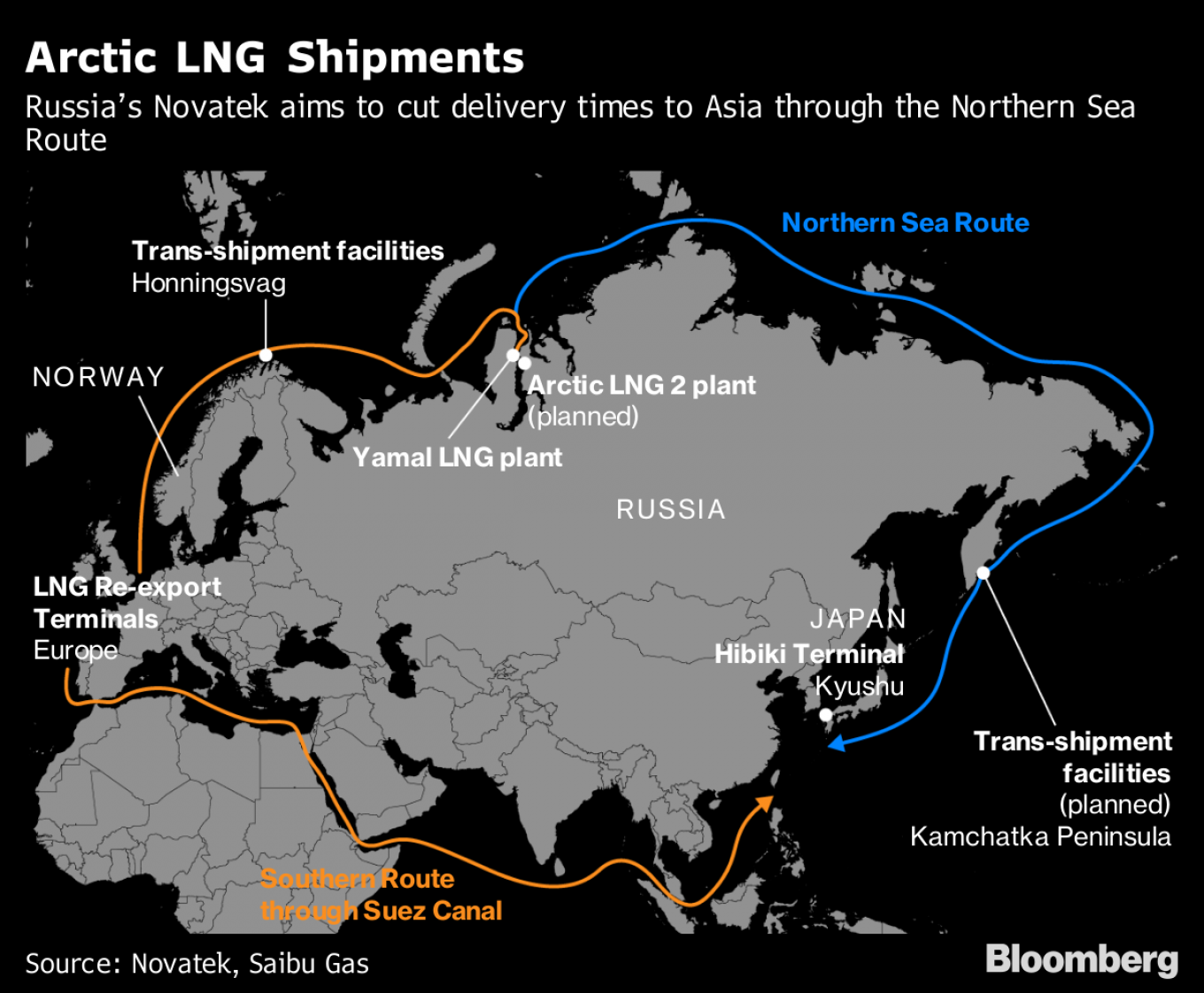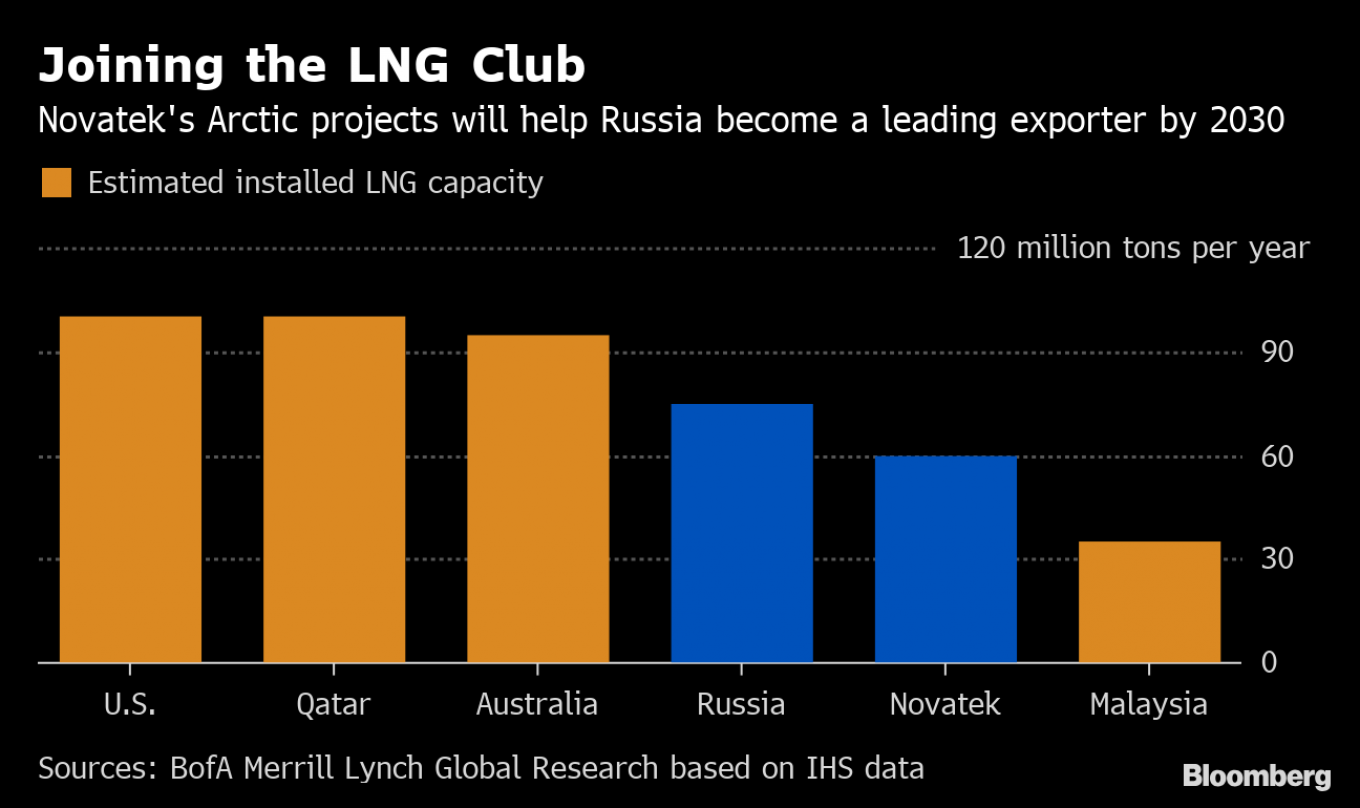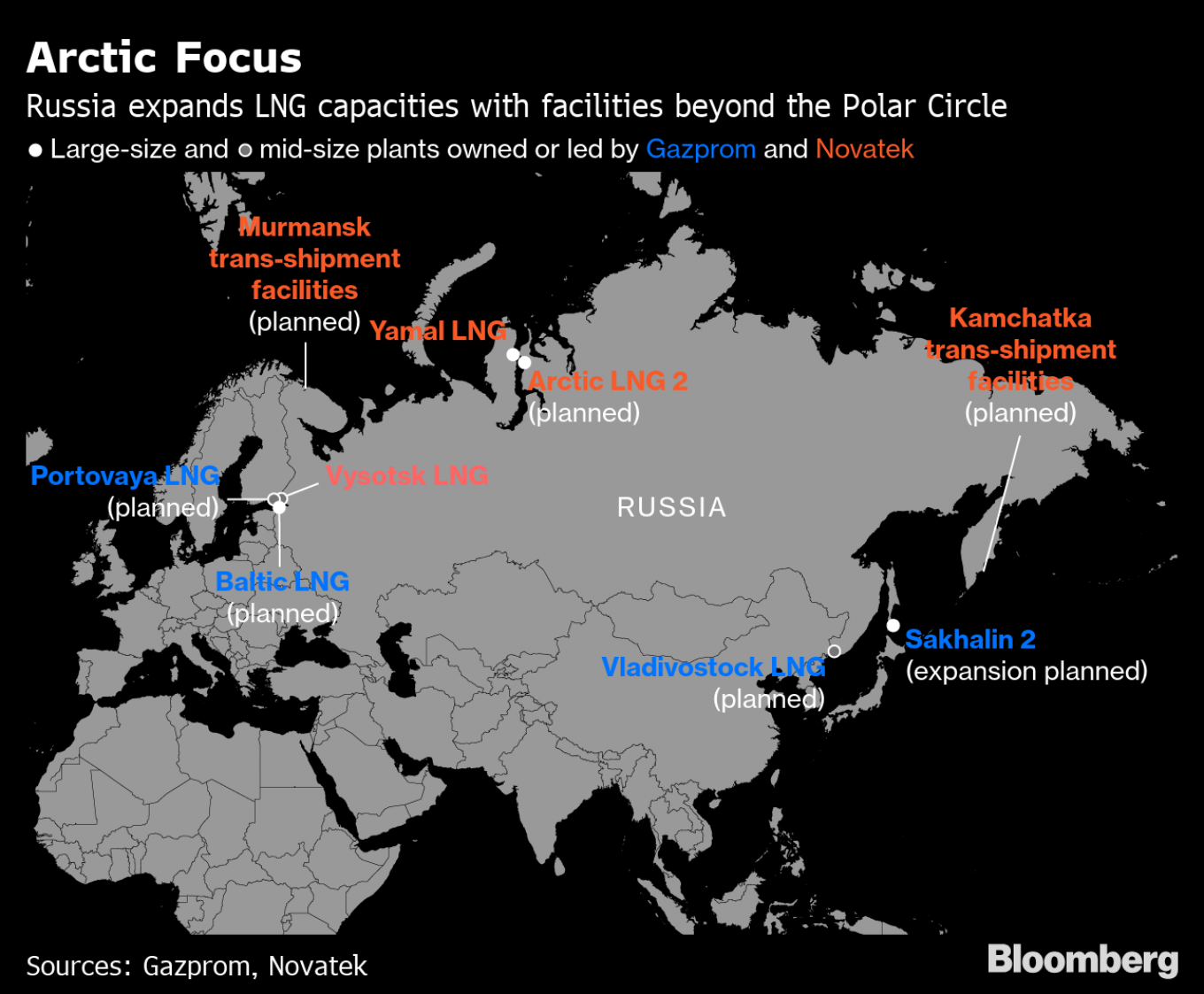Almost 1,500 miles from Moscow, the tiny port of Sabetta nestles in a desolate Russian Arctic peninsula. A former outpost for Soviet geologists, it’s now the site of Russia’s most ambitious liquefied natural gas project, operated by a company that only entered the market just over a year ago.
Several times a week, a giant tanker leaves this remote place carrying the super-chilled fuel to buyers in Europe and Asia. It’s not the only LNG plant beyond the Arctic Circle, but it’s by far the largest.
Novatek PJSC, the main shareholder of the Yamal LNG plant, says plans for further projects will transform Russia into one of the biggest exporters of the fuel within a decade.
Already the world’s top exporter of pipeline gas and second-biggest shipper of crude oil, exports from Sabetta are giving President Vladimir Putin’s Russia another conduit into the world economy for the country’s unrivaled energy resources.
“Russia can be in the top four main LNG exporters,” Novatek’s Chief Financial Officer Mark Gyetvay said in an interview in London.
Showcasing the potential
Novatek has demonstrated that it’s possible to produce and liquefy the fuel in such harsh conditions at competitive prices and ship it to markets thousands of miles away in Europe and Asia. That’s helped by receding Arctic ice which is allowing a specially built fleet of strengthened tankers to ship fuel along Russia’s northern coast.
This week, Putin will tout the potential for development of Russia’s hydrocarbons at the International Arctic Forum in St. Petersburg. Russia’s leader has been a long-standing supporter of developing oil and gas resources locked under the region’s permafrost.
 Arctic LNG Shipments Bloomberg
Arctic LNG Shipments BloombergWhen opening the first production train of the Yamal LNG project in late 2017, Putin said the region gives Russia the opportunity to take up the fuel’s “niche it deserves.”
“We can boldly say that in this century and the next, Russia will expand thanks to the Arctic,” he said at that time.
Novatek, whose biggest shareholders include Russian billionaires Leonid Mikhelson and Gennady Timchenko, as well as French energy giant Total SA, became Russia’s top LNG producer after starting up its plant in the Yamal peninsula almost two years ago.
The facility reached its full capacity at the end of 2018, ahead of schedule, doubling Russia’s share of the global LNG market to 8 percent.
The gas producer has aggressive plans to command a 10th of the global market by 2030, Gyetvay said, and position Russia as one of the world’s largest exporters alongside the U.S., Qatar and Australia.
 Joining the LNG Club Bloomberg
Joining the LNG Club BloombergAll three of Yamal LNG’s production units, with a combined actual capacity of 17.5 million tons a year, are now online. Novatek is attracting partners for a second plant, the so-called Arctic LNG 2 project, which is expected to come online in 2022.
The company is also considering commissioning a third facility and may increase its LNG production target for 2030 by about 20 percent, to as much as 70 million tons a year.
Russia, the world’s largest gas exporter, has been slow to join the global LNG boom as it has focused investment on pipeline supplies to Europe. Until recently, the country had just one liquefaction project in operation, the Gazprom PJSC-led Sakhalin 2 project near Japan with an annual capacity of about 10 million tons.
The country has now taken an interest in the market for tanker-borne fuel amid growing global LNG demand and more difficult relations with its customers in the European Union.
Vast reserves
Russia’s Energy Ministry pegs total gas in place within the region at about 210 trillion cubic meters, or over 70 percent of the nation’s total. Novatek’s Arctic gas reserves are “conservatively” estimated at about 3.3 trillion cubic meters, Gyetvay said.
“We believe that Russia could be the fourth or even the third” biggest holder of LNG production capacity, said Karen Kostanian, Moscow-based oil and gas analyst for Bank of America Merrill Lynch.
The resources are located more than 5,000 kilometers (about 3,100 miles) away from key markets in Asia and are almost 4,000 kilometers from the European trading hub at the port of Rotterdam. That requires extensive shipping capability.
The freezing environment also means Novatek has to produce natural gas at temperatures as low as minus 56 degrees Celsius (about minus 69 Fahrenheit), according to regional government data. This requires special techniques for construction in permafrost areas, including installing pylons in ice, and for ships to navigate frozen routes.
Furthermore, not only does Novatek manage in the harsh environment but it sees the Arctic’s location as a competitive advantage, Gyetvay said, because the lower temperatures actually make production costs cheaper because less energy is needed to chill the gas.
The cost of producing Yamal feedstock gas is only around $0.1 per million British thermal unit, whereas U.S. producers typically buy their gas on a market such as the Henry Hub, where prices are currently about $2.60.
Eyes on the prize
After starting up its $27 billion Yamal LNG project, Novatek is finalizing the partnership structure for the planned Arctic LNG 2 project.
 Arctic Focus Bloomberg
Arctic Focus BloombergNovatek’s potential has attracted investment from global players from Total to China National Petroleum Corp., a rare bright spot for Russia’s energy segment hit by U.S. and European sanctions.
While Novatek is on the American sanctions list, and the U.S. Congress is considering restricting investment in Russia’s LNG facilities outside the country, it won’t impact the start-up of Arctic LNG 2 or the company’s longer-term expansion plans.
Total, a shareholder in Novatek’s first LNG project, last month signed a deal to buy a 10 percent stake in the second plant. The French major’s commitment could prompt a rush of other potential partners to take stakes in the project, Gyetvay said.
Whether other companies buy stakes in Arctic LNG 2 or not, Novatek will move forward with it regardless. The company is already doing pre-marketing for the future cargoes, discussing potential off-takers and volumes, Gyetvay said.
Last week, Novatek signed 15-year agreements with Vitol SA and Repsol SA to supply each with 1 million tons of LNG a year from the Arctic LNG 2 and other projects.
“We’re basically at that point in time when the train has started to move and it’s time to jump on or miss it,” Gyetvay said.
